 For the first time in a long while, I watched the finals of a match while simultaneously in a chat room filled with fans of tennis. Fans of tennis really want close matches. Perhaps this explains the popularity of basketball. In basketball, it’s difficult, by and large, to dominate another team. The scores are usually close enough that a team can make a run to close a gap, and a team can make a run to increase that gap. In a best of 7 series, it’s hard for a team to sweep 4-0. A team can adjust their tactics in an attempt to neutralize a key player from scoring.
For the first time in a long while, I watched the finals of a match while simultaneously in a chat room filled with fans of tennis. Fans of tennis really want close matches. Perhaps this explains the popularity of basketball. In basketball, it’s difficult, by and large, to dominate another team. The scores are usually close enough that a team can make a run to close a gap, and a team can make a run to increase that gap. In a best of 7 series, it’s hard for a team to sweep 4-0. A team can adjust their tactics in an attempt to neutralize a key player from scoring.
By contrast, the top players are the top players for a reason. Nadal is perhaps the toughest guy to keep up with off the ground. If a player like David Ferrer, who is excellent off the ground, can’t keep up with Nadal, how can one expect Milos Raonic, a guy who relies on his huge serve to win games, who lacks the footspeed and consistency to control rallies to handle Nadal. Brad Gilbert asserted that if Nadal gets in a rally with Raonic, he would win 90% of the times.
To the untrained eye, or at least to Nadal-haters, Raonic was playing poorly and Nadal was doing “nothing” special. This shows a lack of understanding of the game, especially Nadal’s game.
Nadal has two facets to his game: offense and defense. Most players know the best way to beat Nadal is to overpower him. By hitting hard, it limits what Nadal can do, and Nadal goes into a defensive mode. He knows that most players, when playing aggressive shot after aggressive shot, increase the likelihood for an error. Nadal often waits for this error to occur.
But the reason players play so aggressively is because a weak shot is treated with ultimate disdain by Nadal. Nadal is looking for a weak shot up the middle, which he’ll then hit to one side line or the other. His goal is not to hit the immediate winner. Instead, he wants to pressure the player to run. Once he gets them on the run, he’ll either target the other sideline, or more often, curl the shot behind the player. He spins a web that leaves his victim in a bigger and bigger bind.
Keep the ball in play, and Nadal makes you run some more. Try to go for a big shot, and Nadal is often quick enough to get to the ball and return it, or the big shot turns into an unforced error.
Milos only looks bad because he’s compelled to play far more aggressive than he normally has to. It’s the same problem every player has playing Nadal. It didn’t help that Raonic was struggling a bit on his serve, and that Nadal was returning well. Nadal’s game is horrible for big guys like Raonic who don’t move that well, and who can’t consistently hit big shots. Soderling, for example, who was similar in height to Raonic, hit a much consistently bigger shot off the ground. Even he struggled to play Nadal, especially on clay. Until Raonic can build his groundstrokes similarly, he’ll find himself mostly relegated to where he is now, at the fringe of the top ten.
Nadal, for his part, appears to have worked on his serve and his return game. For some reason, he can go off and come back with noticeable improvements while Federer and Murray go off, and come back looking about the same, and sometimes slightly worse.
Andy Murray and Colin Fleming reached the finals of the doubles championships but lost to Peya and Soares.
Next week: Cincinnati, the last Masters 1000, prior to the US Open.



![[Paris] Djokovic finishes post US Open tournaments undefeated with win over Ferrer](https://www.essentialtennis.com/wp-content/uploads/2013/11/20131103nole-500x383.jpg)
![[Shanghai] Djokovic wins the China double, adding Shanghai title to Beijing](https://www.essentialtennis.com/wp-content/uploads/2013/10/20131013nole-500x383.jpg)
![[Shanghai, SF] del Potro upsets Nadal in awesome display of power](https://www.essentialtennis.com/wp-content/uploads/2013/10/20131012delpo-500x383.jpg)

![[Cincinnati] Nadal wins 26th Masters 1000 title with win over Isner 7-6, 7-6](https://www.essentialtennis.com/wp-content/uploads/2013/08/20130818rafa-500x383.jpg)